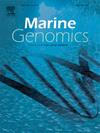果胶降解黄杆菌科细菌GSB9的全基因组序列
IF 1.5
4区 生物学
Q4 GENETICS & HEREDITY
引用次数: 0
摘要
果胶低聚糖被认为是潜在的益生元,可能是由果胶降解酶产生的。在这里,我们报道了从韩国海水中分离到的果胶降解海洋细菌黄杆菌科细菌GSB9的全基因组序列。全基因组测序结果显示,该染色体全长3630376 bp, G + C含量为36.6 mol%,编码3100个蛋白编码序列(CDSs)、40个trna和6个16S-23S-5S rnas。基因组序列分析显示,该菌株具有多个预测编码果胶降解酶的基因。我们的分析可能有助于该菌株在不同工业中对果胶的应用。本文章由计算机程序翻译,如有差异,请以英文原文为准。
Complete genome sequence of pectin-degrading Flavobacteriaceae bacterium GSB9
Pectic oligosaccharides, which are considered to be potential prebiotics, may be generated by pectin-degrading enzymes. Here, we report the complete genome sequence of the pectin-degrading marine bacterium, Flavobacteriaceae bacterium GSB9, which was isolated from seawater of South Korea. The complete genome sequence revealed that the chromosome was 3,630,376 bp in size, had a G + C content of 36.6 mol%, and was predicted to encode 3100 protein-coding sequences (CDSs), 40 tRNAs, and six 16S–23S-5S rRNAs. Genome sequence analysis revealed that this strain possesses multiple genes predicted to encode pectin-degrading enzymes. Our analysis may facilitate the future application of this strain against pectin in various industries.
求助全文
通过发布文献求助,成功后即可免费获取论文全文。
去求助
来源期刊

Marine genomics
生物-遗传学
CiteScore
3.60
自引率
5.30%
发文量
50
审稿时长
29 days
期刊介绍:
The journal publishes papers on all functional and evolutionary aspects of genes, chromatin, chromosomes and (meta)genomes of marine (and freshwater) organisms. It deals with new genome-enabled insights into the broader framework of environmental science. Topics within the scope of this journal include:
• Population genomics and ecology
• Evolutionary and developmental genomics
• Comparative genomics
• Metagenomics
• Environmental genomics
• Systems biology
More specific topics include: geographic and phylogenomic characterization of aquatic organisms, metabolic capacities and pathways of organisms and communities, biogeochemical cycles, genomics and integrative approaches applied to microbial ecology including (meta)transcriptomics and (meta)proteomics, tracking of infectious diseases, environmental stress, global climate change and ecosystem modelling.
 求助内容:
求助内容: 应助结果提醒方式:
应助结果提醒方式:


